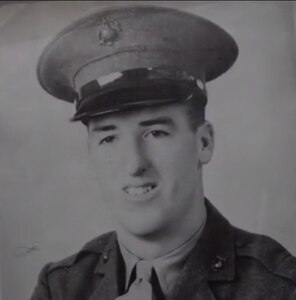Marine Killed In World War II Accounted For (Murray)17-088 | August 11, 2017
Photos
The Defense POW/MIA Accounting Agency (DPAA) announced today that the remains of a U.S. serviceman, unaccounted for since World War II, have been identified and are being returned to his family for burial with full military honors. Marine Corps Pfc. George B. Murray, 20, of Oceano, California, will be buried August 18, in Arroyo Grande, California. In November 1943, Murray was assigned to Company B, 1st Battalion, 2nd Marines Regiment, 2nd Marine Division, which landed against stiff Japanese resistance on the small island of Betio in the Tarawa Atoll of the Gilbert Islands, in an attempt to secure the island. Over several days of intense fighting at Tarawa, approximately 1,000 Marines and Sailors were killed and more than 2,000 were wounded, but the Japanese were virtually annihilated. Murray was killed on the first day of the battle, Nov. 20, 1943. Despite the heavy casualties suffered by U.S. forces, military success in the battle of Tarawa was a huge victory for the U.S. military because the Gilbert Islands provided the U.S. Navy Pacific Fleet a platform from which to launch assaults on the Marshall and Caroline Islands to advance their Central Pacific Campaign against Japan. In the immediate aftermath of the fighting on Tarawa, U.S. service members who died in the battle were buried in a number of battlefield cemeteries on the island. The 604th Quartermaster Graves Registration Company conducted remains recovery operations on Betio between 1946 and 1947, but Murray’s remains were not identified. All of the remains found on Tarawa were sent to the Schofield Barracks Central Identification Laboratory for identification in 1947. By 1949, the remains that had not been identified were interred in the National Memorial Cemetery of the Pacific (NMCP) in Honolulu. In August and September 2010, a Joint POW/MIA Accounting Command (now DPAA) recovery team conducted an archaeological mission on Betio Island. During the mission, the team received a unilateral turnover of possible human remains from the Kiribati Police. The remains were sent to the laboratory for analysis. To identify Murray’s remains, scientists from DPAA and the Armed Forces Medical Examiner System used mitochondrial DNA (mtDNA) analysis, which matched a maternal family member, dental, anthropological and chest radiograph comparison analysis, which matched his records, as well as circumstantial and material evidence. The support from the Republic of Kiribati was vital to the success of this recovery. Of the 16 million Americans who served in World War II, more than 400,000 died during the war. Currently there are 73,041 service members (approximately 26,000 are assessed as possibly-recoverable) still unaccounted for from World War II. Murray’s name is recorded on the Walls of the Missing at an American Battle Monuments Commission site along with the other MIAs from WWII. A rosette will be placed next to his name to indicate he has been accounted for. For additional information on the Defense Department’s mission to account for Americans who went missing while serving our country, visit the DPAA website at www.dpaa.mil, find us on social media at www.facebook.com/dodpaa or call (703) 699-1420. |
We do not have information on individuals beyond what is listed on this site.
For more information, visit www.dpaa.mil or call 703-699-1420.
We are not associated with any government agency.

